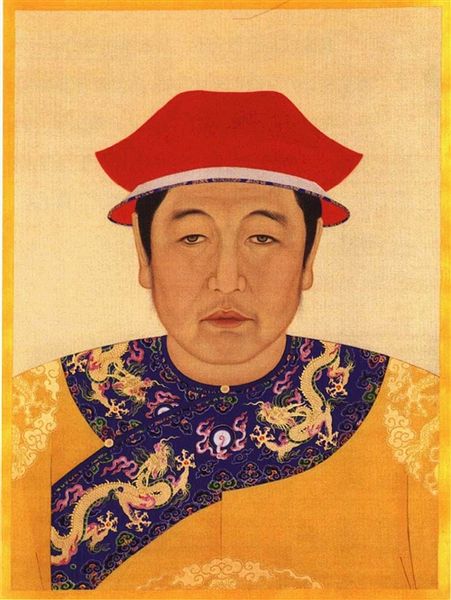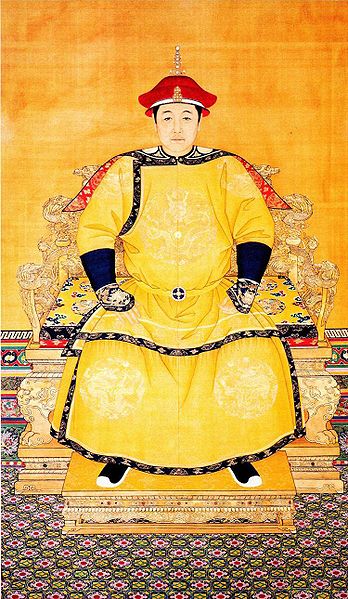<Back to Index>
- Chemist and Physicist Johann Josef Loschmidt, 1821
- Dramatist Isabella Augusta, Lady Gregory, 1852
- 3rd Emperor of the Qing Dynasty Shunzhi, 1638
PAGE SPONSOR


The Shunzhi Emperor (Chinese: 順治帝; 15 March 1638 – 5 February 1661) was the third emperor of the Manchu led Qing dynasty, and officially the first Qing emperor to rule over China from 1644 to 1661. He ascended to the throne at the age of five (six according to traditional Chinese age reckoning) in 1643 upon the death of his father Hong Taiji, but actual power during the early part of his reign lay in the hands of the appointed regents, Princes Dorgon (posthumously titled Emperor Chengzong) and Jirgalang. With the Qing pacification of the former Ming provinces almost complete, he died still a young man, in circumstances that have lent themselves to rumour and speculation. He was succeeded by his son Xuanye, who reigned as the Kangxi emperor.
In the midst of much upheaval, the Manchus seized control of Beijing in June 1644, and in October of the same year the Shunzhi emperor's uncle, the chief regent Prince, proclaimed the Qing dynasty to be the legitimate successor to the Ming Dynasty. Therefore, although the Shunzhi emperor was not the founder of the Qing dynasty, he was the first Qing emperor of China.
One of Dorgon's most controversial decisions was his 1646 imperial edict (the "Queue Order") which forced all Han Chinese men, on pain of death, to adopt the Manchu style of dress, including shaving the front of their heads and combing the remaining hair into a queue. To the Manchus this policy might both be a symbolic act of submission and in practical terms an aid in identification of friend from foe, however for the Han Chinese it went against their traditional Confucian values. Unsurprisingly, it was deeply unpopular and, together with other policies unfavourable towards the Han Chinese, might account for the increasingly steep resistance met by Qing forces after 1646. Hundreds of thousands of people were killed before all of China was brought into compliance.
His mother was the Empress Dowager Xiaozhuang who was an excellent politician during the period. The young emperor disliked his uncle, the chief regent Prince Dorgon, and after Emperor Chengzong's (posthumous title) death in 1650 the emperor stripped both him and Dorgon's brother, Dodo, of their titles and assumed full imperial authority.
During his short reign, the Shunzhi emperor encouraged the Han Chinese to
participate in government activities. He was a scholar and employed Han
Chinese to teach his children. He was also an open minded emperor and
relied on the advice of Johann Adam Schall von Bell 湯若望, a Jesuit from Germany, for guidance ranging from astronomy,
technologies, to tips for governing an empire. Shunzhi also elevated
Schall to his personal mentor and was given free access to the palace. The
emperor married his mother's niece, but demoted the empress several
years later. In 1661, Shunzhi's favourite concubine Donggo suddenly
died as a result of grief over the loss of a child. Overwhelmed with
grief himself, Shunzhi contracted smallpox and died shortly thereafter. Before he died, he appointed four regents to govern for his child son, Xuanye - Oboi, Sonin, Suksaha, and Ebilun. According to official sources, the Shunzhi Emperor died in 1661 of smallpox. It was also believed by some that the young emperor did not pass away but left the palace to become a monk. He was interred in the Eastern Qing Tombs (清東陵), 125 kilometers / 75 miles east of Beijing, in the Xiaoling (孝陵) mausoleum complex (known in Manchu as the Hiyoošungga Munggan). Hong
Taiji had changed the name of the dynasty from Later Jin to Qing in
1636 because of the fraternal struggles and skirmishes between brothers
and half brothers for the throne. According to Taoist philosophy, the
name Jin has the meaning of metal and fire in its constituent, thereby
igniting the tempers of the brothers of the Manchu Royal household into
open conflicts and wars. Huangtaiji therefore adopted the new name of
Qing 清, the Chinese character of which has the water symbol [3 strokes]
on its left hand side. The name, which means clear and transparent,
with its water symbol was hoped to put out the feud among the brothers
of the Manchu Royal household. Because
of power issues in the Qing's ancestors' way, Shunzhi ultimately took
another step to consolidate the power of the emperor. According to the
old way, the 8 Banners were passed with succession much like how
Nurhaci decided to give his Yellow Banners to Dorgun, but could
potentially be controlled by someone like Huang Taji who switched the
Banners. To solve this problem, Shunzi ordered the Upper 3 Banners -
Plain Yellow, Striped Yellow, and Plain White to be under the control
of the emperor. This would be maintained until Yongzheng and Qianlong's
reign when they took the last step and controlled all 8 Banners. It's also noteworthy that the empire was generally clean from corrupt officials as Shunzhi despised corrupt officials. Information
is not clear, but it is said that Shunzhi later become a monk. Although
not officially stated in history, it is said he later died of smallpox.
He was later erased from history shortly after his death. Shunzhi
was buried in what later came to be known as the "Eastern Qing Tombs"
northeast of Beijing, one of two Qing imperial cemeteries.